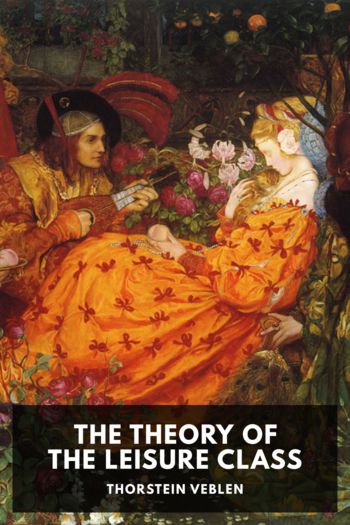Progress and Poverty - Henry George (distant reading TXT) 📗

- Author: Henry George
Book online «Progress and Poverty - Henry George (distant reading TXT) 📗». Author Henry George
Yet, it may be said, that even this increase is a great one. Twenty-two thousand persons descended from a single pair in 2,150 years is far short of the Malthusian rate. Nevertheless, it is suggestive of possible overcrowding.
But consider. Increase of descendants does not show increase of population. It could only do this when the breeding was in and in. Smith and his wife have a son and daughter, who marry respectively someone else’s daughter and son, and each have two children. Smith and his wife would thus have four grandchildren; but there would be in the one generation no greater number than in the other—each child would have four grandparents. And supposing this process were to go on, the line of descent might constantly spread out into hundreds, thousands and millions; but in each generation of descendants there would be no more individuals than in any previous generation of ancestors. The web of generations is like latticework or the diagonal threads in cloth. Commencing at any point at the top, the eye follows lines which at the bottom widely diverge; but beginning at any point at the bottom, the lines diverge in the same way to the top. How many children a man may have is problematical. But that he had two parents is certain, and that these again had two parents each is also certain. Follow this geometrical progression through a few generations and see if it does not lead to quite as “striking consequences” as Mr. Malthus’ peopling of the solar systems.
But from such considerations as these let us advance to a more definite inquiry. I assert that the cases commonly cited as instances of overpopulation will not bear investigation. India, China, and Ireland furnish the strongest of these cases. In each of these countries, large numbers have perished by starvation and large classes are reduced to abject misery or compelled to emigrate. But is this really due to overpopulation?
Comparing total population with total area, India and China are far from being the most densely populated countries of the world. According to the estimates of MM. Behm and Wagner, the population of India is but 132 to the square mile and that of China 119, whereas Saxony has a population of 442 to the square mile; Belgium 441; England 422; the Netherlands 291; Italy 234 and Japan 233.22 There are thus in both countries large areas unused or not fully used, but even in their more densely populated districts there can be no doubt that either could maintain a much greater population in a much higher degree of comfort, for in both countries is labor applied to production in the rudest and most inefficient ways, and in both countries great natural resources are wholly neglected. This arises from no innate deficiency in the people, for the Hindu, as comparative philology has shown, is of our own blood, and China possessed a high degree of civilization and the rudiments of the most important modern inventions when our ancestors were wandering savages. It arises from the form which the social organization has in both countries taken, which has shackled productive power and robbed industry of its reward.
In India from time immemorial, the working classes have been ground down by exactions and oppressions into a condition of helpless and hopeless degradation. For ages and ages the cultivator of the soil has esteemed himself happy if, of his produce, the extortion of the strong hand left him enough to support life and furnish seed; capital could nowhere be safely accumulated or to any considerable extent be used to assist production; all wealth that could be wrung from the people was in the possession of princes who were little better than robber chiefs quartered on the country, or in that of their farmers or favorites, and was wasted in useless or worse than useless luxury, while religion, sunken into an elaborate and terrible superstition, tyrannized over the mind as physical force did over the bodies of men. Under these conditions, the only arts that could advance were those that ministered to the ostentation and luxury of the great. The elephants of the rajah blazed with gold of exquisite workmanship, and the umbrellas that symbolized his regal power glittered with gems; but the plow of the ryot was only a sharpened stick. The ladies of the rajah’s harem wrapped themselves in muslins so fine as to take the name of woven wind, but the tools of the artisan were of the poorest and rudest description, and commerce could only be carried on, as it were, by stealth.
Is it not clear that this tyranny and insecurity have produced the want and starvation of India; and not, as according to Buckle, the pressure of population upon subsistence that has produced the want, and the want the tyranny.23 Says the Rev. William Tennant, a chaplain in the service of the East India Company, writing in 1796, two years before the publication of the Essay on Population:
“When we reflect upon the great fertility of Hindostan, it is amazing to consider the frequency of famine. It is evidently not owing to any sterility of soil or climate; the evil must be traced to some political cause, and it requires but little penetration to discover it in the avarice and extortion of the various governments. The great spur to industry, that of security, is taken away. Hence no man raises more grain than is barely sufficient for himself, and the first unfavorable season produces a famine.
“The Mogul government at no period offered full security to the prince, still less to his vassals; and to peasants the most scanty protection of all. It was





Comments (0)